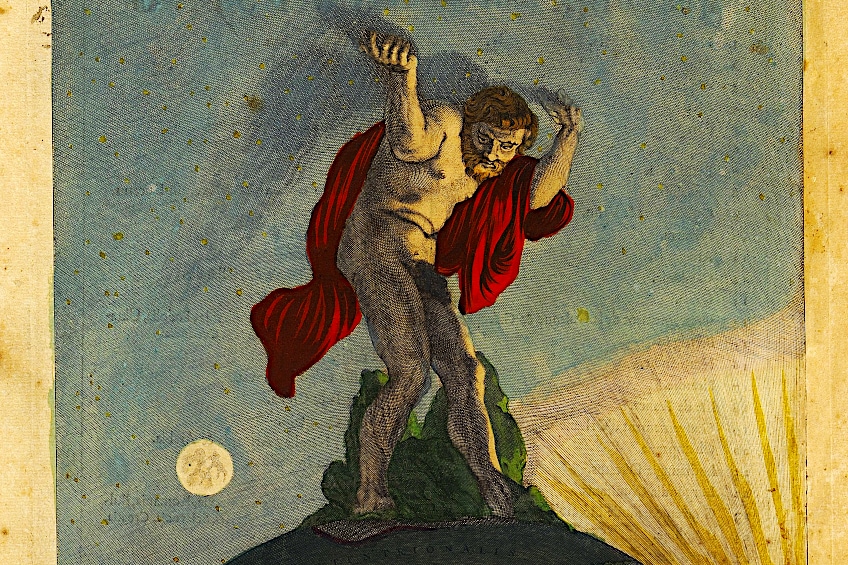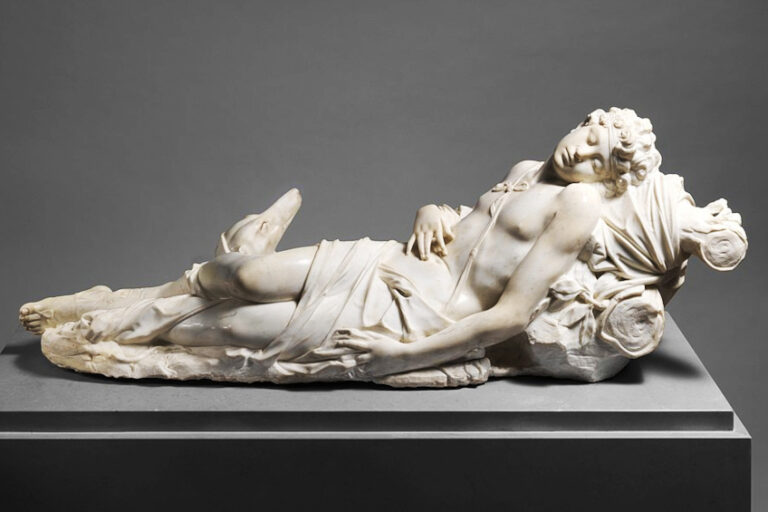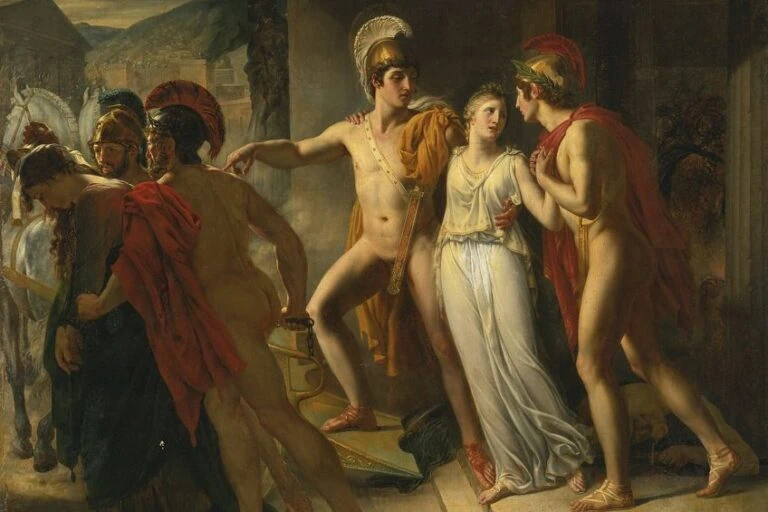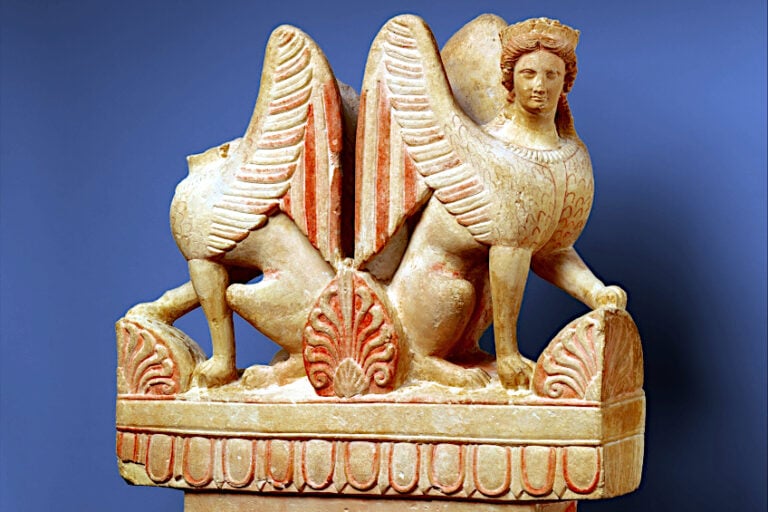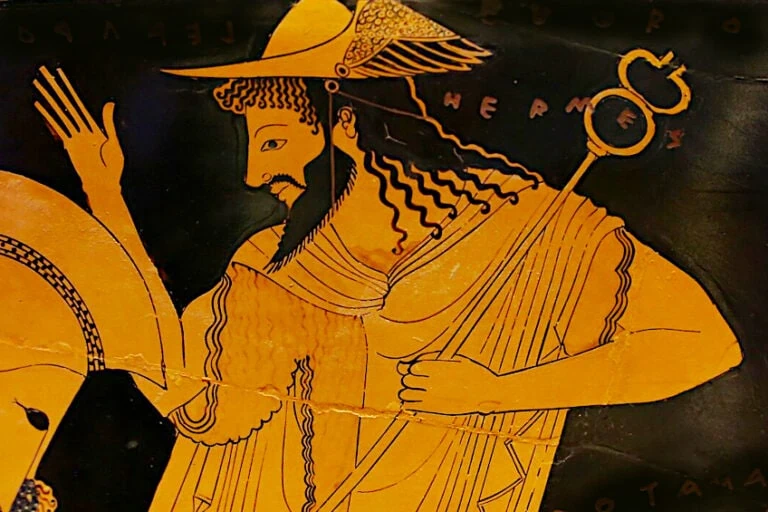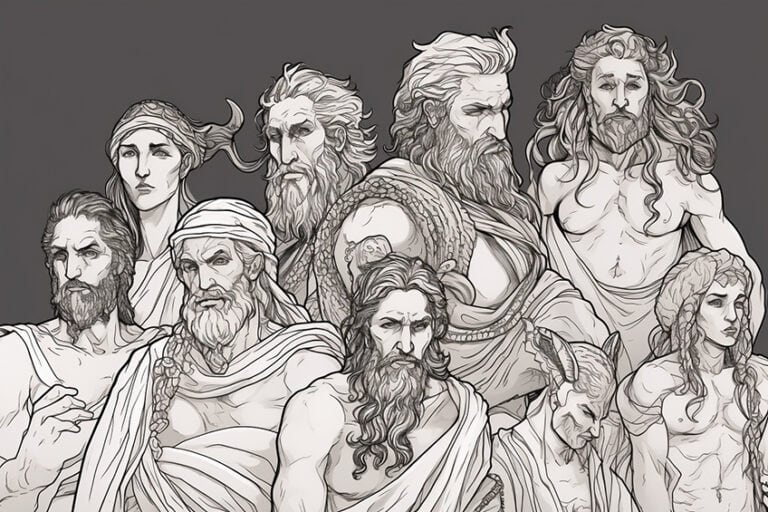Greek God Atlas – The Titan Bearing the Weight of the Heavens
Have you ever wondered where the phrase, “carrying the weight of the world on your shoulders”, originates? Or who exactly is the Greek god Atlas in the annals of legend? Atlas is perhaps a familiar name with a history that reaches deeper than the seas and further than the stars. Below, we explore the enigmatic history of Atlas and how his influence endures even to our current day.
Contents
Overview
| Name | Atlas |
| Gender | Male |
| God of | Endurance and strength |
| Personality | Courageous, determined, and wily |
| Symbols | The Celestial Sphere |
| Consorts | Pleione, Hesperia, and Aethra |
| Children | The Pleiades, the Hyades, the Hesperides, Kalypso, Dione, and Hyas |
| Parents | Iapetos and Klymene/Asia |
The Greek god Atlas is one of the Titans of Greek mythology and was believed by the ancient Greeks to stand at the western edge of the world. His task was to hold the heavens apart from the earth with his immense strength for the rest of eternity.
This punishment, given to him by the Olympian Zeus, is perhaps what he is most famously known for, however, he also plays many roles outside of this. Atlas also appears in several heroic myths and holds a strong connection to the stars, astronomy, and navigation.
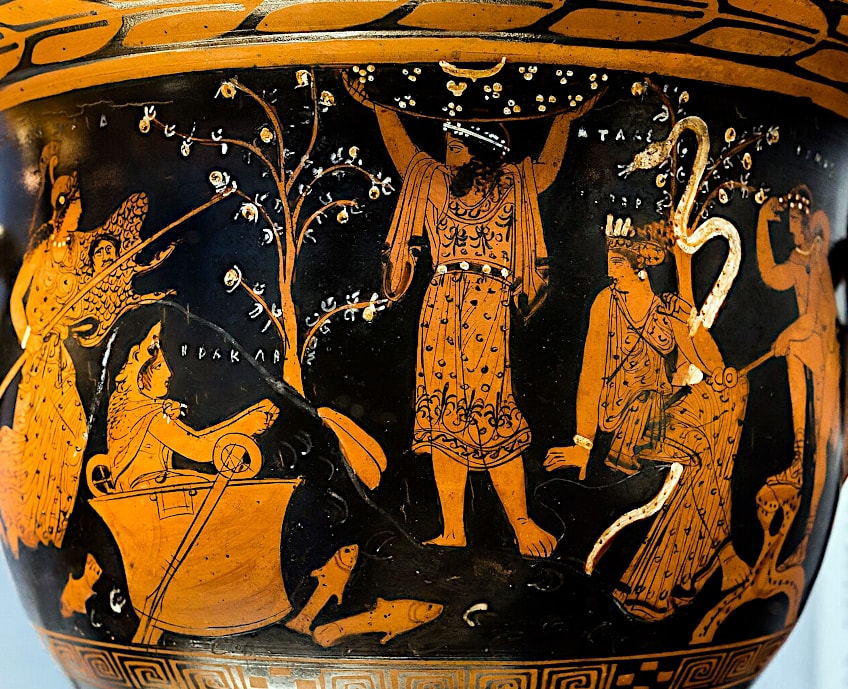 Attic red-figure bell-krater showing Atlas (in the center) supporting the heavens in the Garden of the Hesperides as Athena and Heracles approach (from the left) (c. 410-400 BCE); ArchaiOptix, CC BY-SA 4.0, via Wikimedia Commons
Attic red-figure bell-krater showing Atlas (in the center) supporting the heavens in the Garden of the Hesperides as Athena and Heracles approach (from the left) (c. 410-400 BCE); ArchaiOptix, CC BY-SA 4.0, via Wikimedia Commons
Background and Family of the Titan Atlas
The Greek god Atlas is held as the embodiment of endurance. He is the bearer of the heavens and his given epithet Atlas ‘Telamōn’ means ‘enduring’ Atlas. Atlas’ Roman name is the same as his Greek one and is usually attributed to words meaning ‘to bear’ or ‘endure’; although both his name and origins are seen as pre-Grecian and the etymology is still wildly debated.
No current archaeological evidence suggests Atlas himself had a dedicated temple, cult following, or extended mythos, but this is common for the Titans.
He did however have a connection to astronomy and played roles in both the cosmography of the ancient Grecian world and in the myths of Heracles’ 12 Labors and Perseus’ journey.
Family
Atlas is most commonly depicted as a son of Iapetus, the Titan of mortality and one of the 12 Titans birthed by the primordial Titans Uranus and Gaia. His mother, either Klymene or Asia, is one of the 3000 Oceanid daughters of the Titans Oceanus and Tethys who were also Iapetus’ siblings.
This makes Atlas both a second-generation titan and brother to the Titans Menoetius, Epimetheus, and Prometheus.
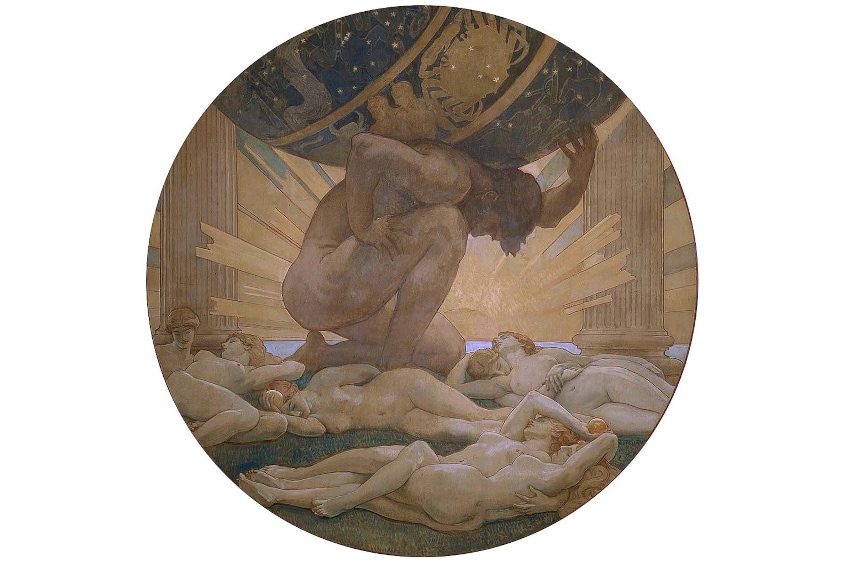 Atlas and the Hesperides by John Singer Sargent (between c. 1922 and 1925); John Singer Sargent, Public domain, via Wikimedia Commons
Atlas and the Hesperides by John Singer Sargent (between c. 1922 and 1925); John Singer Sargent, Public domain, via Wikimedia Commons
He is also considered the father of several groups of gods. Some sources hold him as having fathered the Hesperides by Hesperis daughter of Hesperus; as well as The Pleiades, the Hyades, and his only son Hyas, by the Oceanids Pleione and/or Aethra. He is also proposed as the father of several other daughters such as Maira, Dione, and Kalypso who was famously the lover of Odysseus.
Through his daughter Maia Atlas is also the grandfather of the Greek god Hermes.
The Role of Atlas in Greek Mythology
Greek mythology is used to contextualize and explain the world the ancient Greeks lived in. The stories can cover anything from moral boundaries to the very fabric of creation. The Titan Atlas has very little mythology he stars in, however, the roles he does play impart important information about the world as a whole.
The Titanomachy
You may be wondering as many others do; with him being the same generation as Zeus, is Atlas a god or is Atlas a titan? The question itself is complex to answer as although the Titans are gods, they are not considered Olympian gods. The Titans in Greek mythology are a group placed from their first introduction in the role of ‘what came before’. They are often fundamental, abstract, and/or difficult-to-control, embodiments of forces and qualities.
The Titans’ only group purpose is noted as being the old, defeated gods who ruled before the Olympian gods. The Olympians are called this because they are believed to rule from Mount Olympus.
The Titans have also been theorized to have ruled a primitive but paradise-like golden age, however, their original role in mythology was always meant to be a story of generational succession. Just as the titan Kronus overthrew his father Uranus, so Atlas’ son Zeus overthrew him. Mythological aspects of the Titans may have been borrowed from the Near East, whether this is the case or not however, their primary role in Greek myth is helping to contextualize the cosmos and explain how and why the Olympian gods came to power.
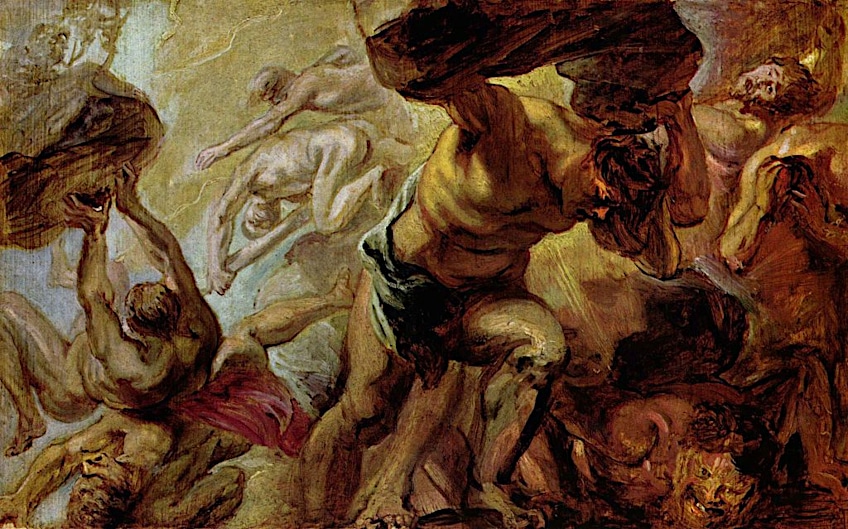 Fall of the Titans by Peter Paul Rubens (c.1637-1638); Peter Paul Rubens, Public domain, via Wikimedia Commons
Fall of the Titans by Peter Paul Rubens (c.1637-1638); Peter Paul Rubens, Public domain, via Wikimedia Commons
Our Atlas was a leader in the battle of the Titans opposing the Olympians during the 10-year war known as the Titanomachy. Though his crime is not specifically stated, it is generally accepted that this answers the question of why was Atlas punished the way that he was.
His punishment was not being thrown into Tartarus like his father Iapetos and many others. He was instead condemned to bear the weight of the heavens at the farthest western reaches of the earth. In the context of the Titanomachy as a war of succession and contextualization of Zeus’ reign, this punishment can be painted as both a symbol and warning of Zeus’ power and authority.
The Heaven-bearer
As the one who holds up the sky, Atlas’ descriptions in Greek mythology place him as both a part of the cosmography and the geography of the world known by the ancient Greeks and later the Romans. The former cosmological role is that he answers the common questions of why the sky is separate from the earth and what are the rules regarding the boundaries and movements of the heavens.
Atlas is the one who maintains the separation and the turning of the heavens on their axis.
The second part is more prominent in the Roman writing tradition, but the Greeks often placed the dwellings of Atlas, the Hesperides, and the Gordons, over the sea and at the far western edge of the earth. These became associated with North Africa’s western regions that lie across the ocean from the Greco-Roman territories and were at one time the extent of the known world. Modern-day Morocco and Libya were most commonly referenced and the vast mountain range found nearby was at some point named, and largely considered as the heaven-bearing Atlas.
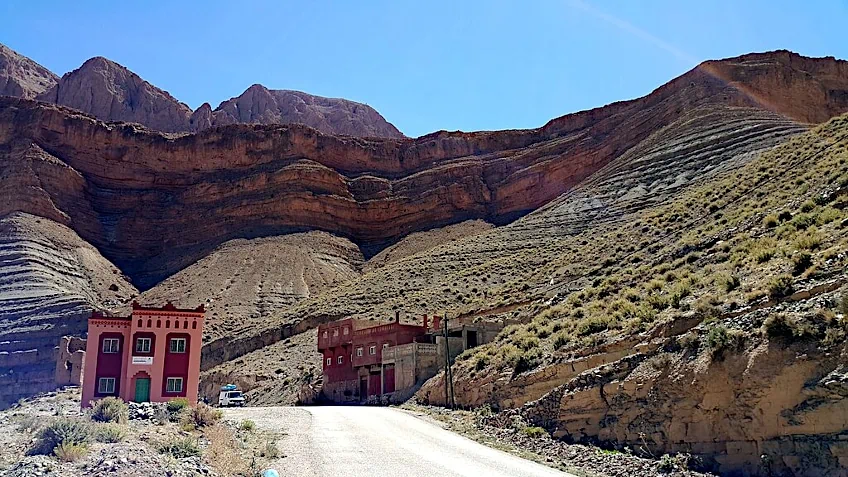 The Atlas Mountains as seen in Morocco; 2babouches, CC BY-SA 4.0, via Wikimedia Commons
The Atlas Mountains as seen in Morocco; 2babouches, CC BY-SA 4.0, via Wikimedia Commons
The Star-Father
While not an official sphere of influence, the Titan Atlas is also frequently tied with the stars. His study of the firmament that reading on his shoulders and the stars moving across it, leaves him with strong ties to astronomy and he is even said to have created the first celestial sphere.
Like many titans, Atlas also plays a strong genealogical role in Greek mythology.
His children are the nymphs known as the Hesperides, and those nymphs referred to as the Hyades and the Pleiades. The latter two groups became star constellations of the same name through either reward for their actions or pity for their grief. Their sole brother Hyas became the constellation Aquarius after being chased by a lion or a boar that would become the constellation Leo that rises with it. It is also through Maia, one of the Pleiades, that the god Hermes is a grandson of Atlas and can be referred to as Atlantius.
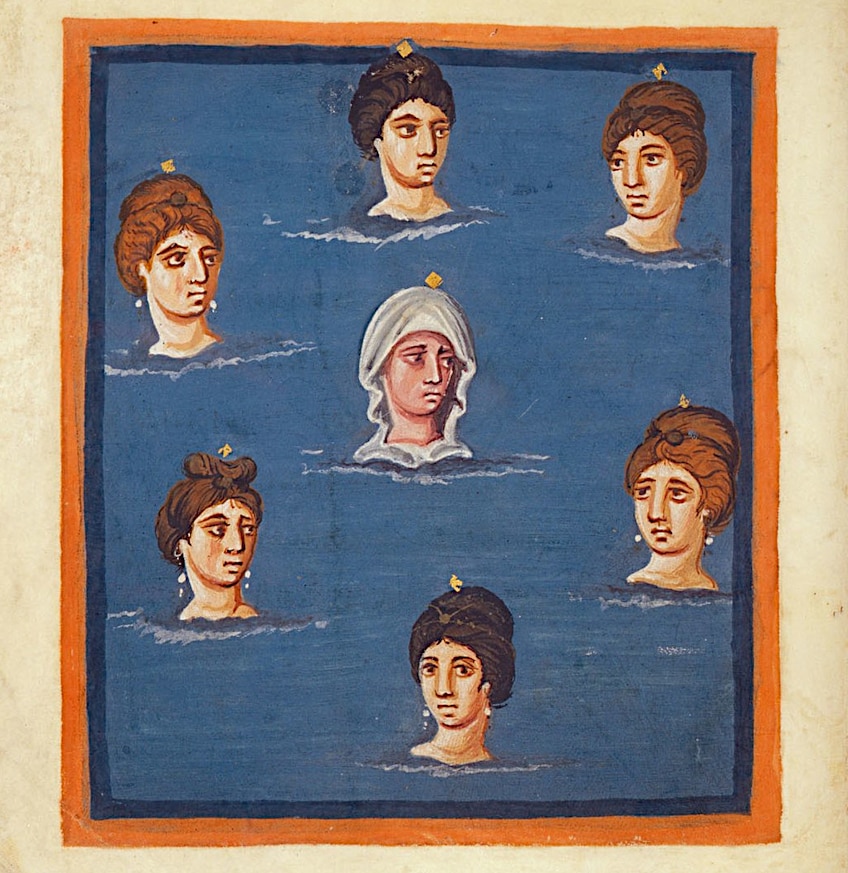 Manuscript illustration showing the Pleiades constellation as seven maidens by Aratus (between c. 830 and 840 CE); Aratus, Public domain, via Wikimedia Commons
Manuscript illustration showing the Pleiades constellation as seven maidens by Aratus (between c. 830 and 840 CE); Aratus, Public domain, via Wikimedia Commons
His connection with stars and the moving of the heavens often confuses people about what is Atlas the god of, with some holding him as the god of astronomy. This title belongs to the Muse Urania, who is also depicted with a celestial sphere as one of her symbols.
Personality and Attributes
Like many other titans, Atlas is a figure we have little information on. With little mythology outside a few variant writings and no evidence of a dedicated cult, we are left to explore how he is portrayed through his descriptors and actions throughout the ages.
Atlas’ Appearance and Traits
Atlas is of course most well-known for his strength of body. He is depicted often in art as fit of form and large of stature as he carries the weight of the ‘world’ on broad shoulders. Less apparent is that Atlas is reputedly equally strong of spirit and mind.
The Titan Atlas is described in Hesiod’s Theogony as Iapetos and Klymene’s ‘stout-hearted’ son.
The connotations of courage and determination would serve him well in his role of leading the Titans in battle against the Olympians. He certainly seems to embody some bravery in his dealings with the sons of Zeus after his punishment. His firm and resolute rejection of Perseus, as well as his attempted trickery to secure his freedom through Hercules, supports the image that the titan possesses a decisive spirit that is as enduring as his body. That is also no light phrase as his lonely task has been attributed by some to be a responsibility shared between the four Titans Koios, Hyperion, Krios, and Atlas’ father Iapetos.
What is might without mind, however? Atlas is by no means all brawn and no brain. Homer’s Odyssey (7th to 6th century BCE) has Athena name him “baneful”, an understandable title for a dangerous past adversary. She also notes Atlas as knowing “all the depths of all the seas”.
His bearing of the heavens affords him a knowledge of the stars and astronomy said by Diodorus to “surpass all others”: and by extension their uses in timekeeping and navigation as used amongst the ancient Greeks. He is even said to have created the first celestial sphere and later comes to be conflated with prosperous and legendary kings of great leadership.
 Roman copy of a Hellenistic sculpture of Atlas holding the celestial sphere known as the Farnese Atlas (2nd Century CE); TyB, CC BY 2.0, via Wikimedia Commons
Roman copy of a Hellenistic sculpture of Atlas holding the celestial sphere known as the Farnese Atlas (2nd Century CE); TyB, CC BY 2.0, via Wikimedia Commons
His encounters with Heracles and Perseus show some of his personality more deeply than mere descriptors. His crafty deal with Heracles displays guile and patience even as it showed equal gullibility. In his encounter with Perseus, he turns Perseus away violently but out of caution of prophesied harm rather than simple arrogance. In these ways, he showcases some measure of wisdom and restraint, especially if one compares him with his hasty and hubristic brother Menoetius.
The Symbols
Atlas’ role as both the physical bearer of the sky and the metaphorical bearer of knowledge of the heavens is exemplified in his official symbol of the celestial sphere, which some credit him as having created the first.
A celestial sphere is a conceptual tool used in spherical astronomy useful for detailing the overall configuration of the Greco-Roman cosmos as well as to describe and measure when and where an object will be located in the sky.
In the celestial sphere, you can see Atlas’ study of – and connection to – the stars and constellations in their motions. Going even further one can even see the related timekeeping and navigation methods used by farmers and sailors in the ancient Greek world that Atlas is reported as learned in. A common misbelief is of Atlas holding the world on his shoulders. The modern globe depiction of Earth is similar in shape to the ancient celestial sphere and is popular in modern artistic renditions of Atlas.
![]() Frontpage of Frederick de Wit’s Atlas with a depiction of Atlas standing on the world holding up the sky (17th Century); Frederik de Wit, Public domain, via Wikimedia Commons
Frontpage of Frederick de Wit’s Atlas with a depiction of Atlas standing on the world holding up the sky (17th Century); Frederik de Wit, Public domain, via Wikimedia Commons
While incorrect, the image of Atlas holding the earth does easily convey the endurance the Titan possesses and the sheer weight of his punishment; however, this is at the cost of the finer details of his attributes and character.
Another symbol is an older representation depicted in Homer’s Odyssey, where Atlas is a sort of sea creature in form and instead holds up pillars that bear the sky. A similar connection was also present in later works portraying Hercules as having built pillars to free the Titan from his punishment much like he did with Atlas’ brother Prometheus. In another way, the Atlas Mountains have also been long associated with the Titan by the time of the Empire of Rome, however, this is not a true symbol like the celestial sphere.
The Mythology of He-Who-Bears-The-Heavens
Atlas’ popular mythology is centralized around his part in the Titanomachy and increasingly reconfigured myths as the ages passed through various Grecian and Roman influences. Most well-known of his myths can be found in the Grecian writings of Heracles’ eleventh labor, and the Roman writings of his run-in with Perseus.
Atlas and Heracles
The 12 Labors of Heracles are a famous myth, with their formal establishment generally attributed to Peisander around the 7th to 6th century BCE. These labors were a set of tasks completed for King Eurystheus of Mycenae. Heracles murdered his wife Megara and their children in the throes of madness and these tasks in service to his cousin were his atonement. After the original 10 were completed two were discounted as Heracles secured aid or payment for them, and the two tasks set to replace them brought the number up to 12.
The 11th task given to Heracles was to retrieve three golden apples from Hera’s garden in the Far West.
The garden was guarded by the dragon Ladon and tended to by the Hesperides, nymphs of sunset, and the west. The Hesperides were also associated with Atlas and are alternatively named the Atlanides as his daughters. On his journey, Heracles came to be advised by Prometheus to seek brother Atlas and in doing so he struck a deal with the Titan.
Heracles would hold Atlas’ burden, the sky, upon his shoulders while the titan would retrieve the apples from the garden of Hesperides.
On Atlas’ return, however, he attempted to trick Heracles into keeping the burden he could never put down. He offered to deliver the apples for Hercules, however, the hero Heracles made his own plan. Hercules agreed and only asked that Atlas temporarily take the burden back so he could adjust his cloak before settling into his task. Atlas complied, placing the apples on the ground before taking up the sky, however, Heracles swiftly grabbed the apples and ran with them instead.
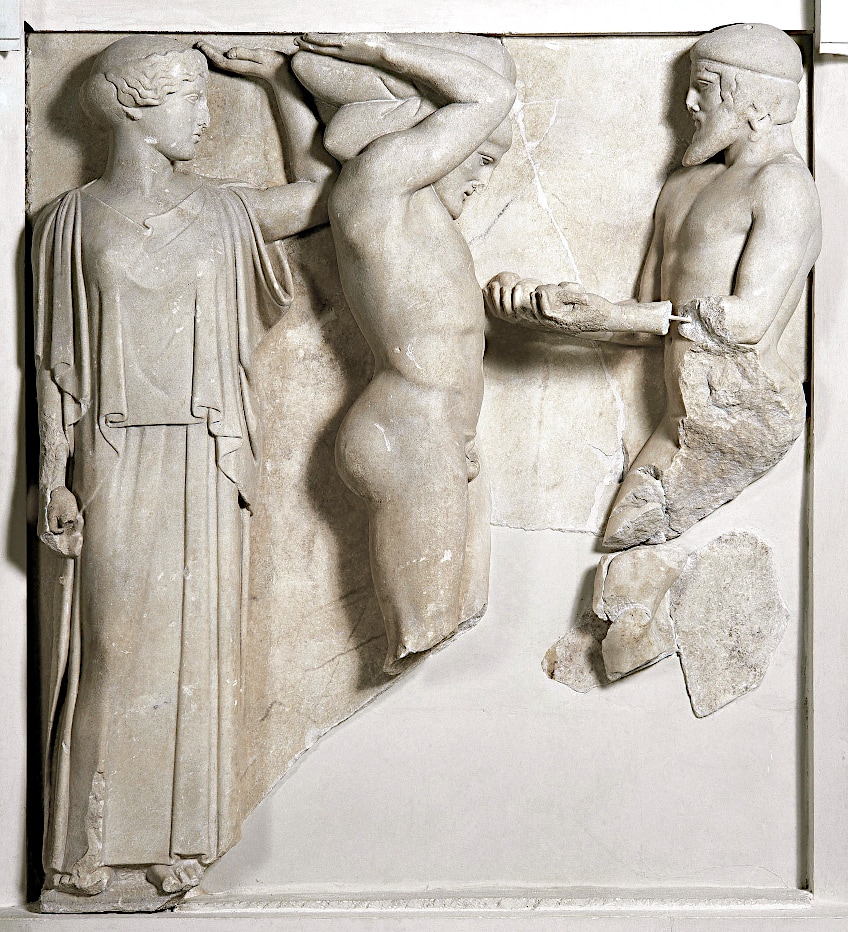 Metope relief depicting Athena aiding Heracles in holding up the sky while Atlas returns with the apples of the Hesperides (470-457 BCE); See page for author, Public domain, via Wikimedia Commons
Metope relief depicting Athena aiding Heracles in holding up the sky while Atlas returns with the apples of the Hesperides (470-457 BCE); See page for author, Public domain, via Wikimedia Commons
In other writings it is said Heracles built pillars to hold up the sky, freeing the Titan Atlas from his punishment just as the hero had once freed Prometheus.
Atlas and Perseus
By the time of the Roman Empire, Atlas and the various inhabitants of the Far West, like the Hesperides and the Gorgons, were already associated with the regions in Northwest Africa, particularly Libya, and Mauretania or modern-day Morocco.
The Roman poet Ovid (43 BCE to 17/18 ACE) expanded an earlier myth where Atlas was a shepherd turned to stone by Perseus using the petrifying sight of the Gorgon Medusa’s head. Combined with some elements of Hercules’s labors, Atlas became a giant and prosperous king of the far western ‘Hesperides’ shore.
Perseus’s journeys brought him to the kingdom where he asked the king for shelter only to be harshly denied. Atlas, having been forewarned about a son of Jupiter, the Roman equivalent of Zeus, coming to steal from his golden apple trees turned him away; first with words and then with force. Eventually, in response to this, the outmatched and angered Perseus raised the Gorgon Medusa’s head and turned the giant Atlas to stone. The king’s body became the vast Atlas Mountain range in Northern Africa, and the gods placed the weight of the heavens and Atlas became the heaven-bearer once more.
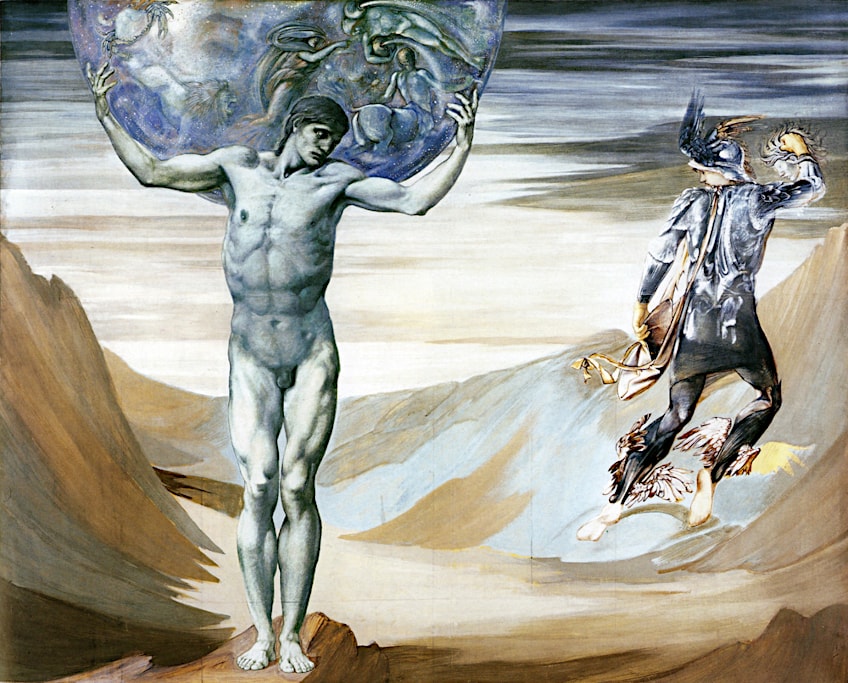 The Perseus Series: Atlas Turned to Stone by Edward Burne-Jones (1878); Edward Burne-Jones, Public domain, via Wikimedia Commons
The Perseus Series: Atlas Turned to Stone by Edward Burne-Jones (1878); Edward Burne-Jones, Public domain, via Wikimedia Commons
Lesser mythologies place him as the first king of Atlantis and a son of Poseidon according to Plato, or connected with the legendary King of Mauretania who was known for his scholarship in philosophy, mathematics, and astronomy.
The Modern Influence of Atlas
Throughout our study, it is clear to see the aspects of navigation and endurance intrinsically tied to his mythos. The most modern and common applications of Atlas’ Roman name and image reflect these two qualities as well.
The western sea that borders where he was reputed to stand and/or rule depending on the myth has been referred to as Atlantikôi pelágei meaning the ‘sea of Atlas’ or as we now call it the Atlantic Ocean. This was in the mid-6th and 5th centuries BCE but generally, the unenclosed sea was believed to be the all-encompassing river Oceanus. The term Atlantic more accurately referenced the Atlas Mountains in Northwest Africa, a name it still holds.
Following the theme of geography, the name Atlas was given to refer to a collection of maps in the 16th century and is regularly used for this purpose today. Gerardus Mercator did so in reference to a legendary King of Mauretania, analogous to the modern region of Morocco, a man reputed to be skilled in the arts of philosophy, mathematics, and astronomy.
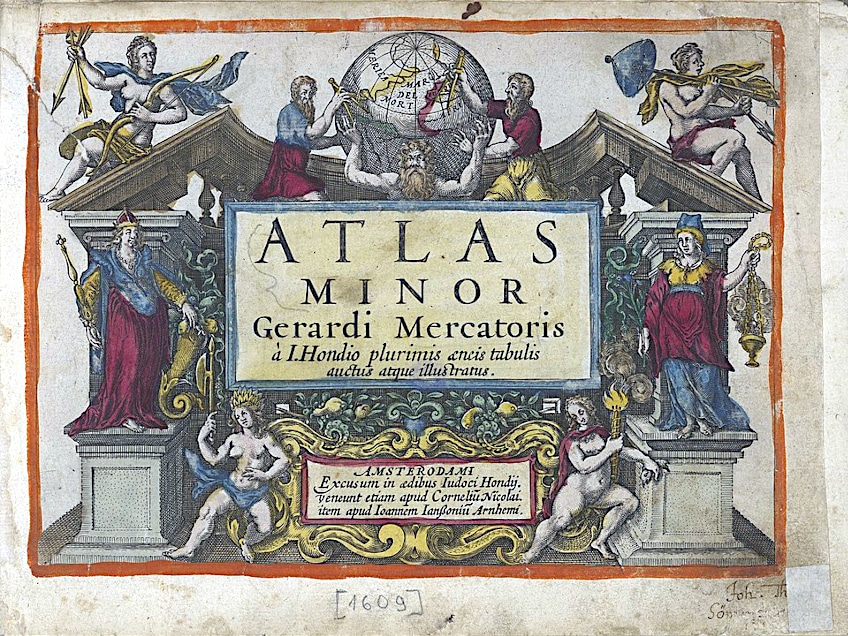 Fronticepiece of the Mercator-Hondius Atlas Minor 1609 edition; National Library of Poland, Public domain, via Wikimedia Commons
Fronticepiece of the Mercator-Hondius Atlas Minor 1609 edition; National Library of Poland, Public domain, via Wikimedia Commons
The search for the mythical lost city of Atlantis which bears Atlas’ name is also alive and well, with its location still a mystery it is nevertheless a legend of gargantuan proportion and influence.
Endurance
The conceptual attributes of Atlas also remain strong in memory, though it is more focused on the element of endurance centered around the popular, if incorrect, representation of Atlas holding the world on his shoulders. The story of Atlas creates an interesting commentary on the nature of strength and endurance.
The portrayal of Atlas, a titan mighty enough to hold up the world is no doubt awe-inspiring. There is a careful message to be found however that strength can be a double-edged sword.
Being strong allows you to carry more than others and for longer than others, and Atlas was strong enough to lead a faction of gods to war. An important thing to remember is that it was Atlas’ strength that got him punished and his strength that hurts him now. With every responsibility comes risk, but no matter how strong you are taking too much responsibility too fast and for too long can only harm yourself. Who but Atlas is strong enough to hold up the heavens? Who but Atlas is strong enough to suffer such a fate for so long? While a modern-day Atlas could be a term of admiration for someone’s strength and endurance in their personal or professional life, it can also serve as a warning.
Much like there is an old proverb about Atlas that alludes to people who commit to large undertakings and meet misfortune, there is a modern-day phrase of ‘bearing the weight of the world on your shoulders’.
The phrase is synonymous with taking on a heavy or large burden, often alone, and sparks reminders that just because you can take on more than your share of responsibilities, it doesn’t mean that you should. The greater your strength to take on burdens, the greater your capacity for suffering from them. The notion of Atlas as critical weight-bearer is even reflected in anatomy, where the junction between the skull and spine is aptly named the “Atlas bone”.
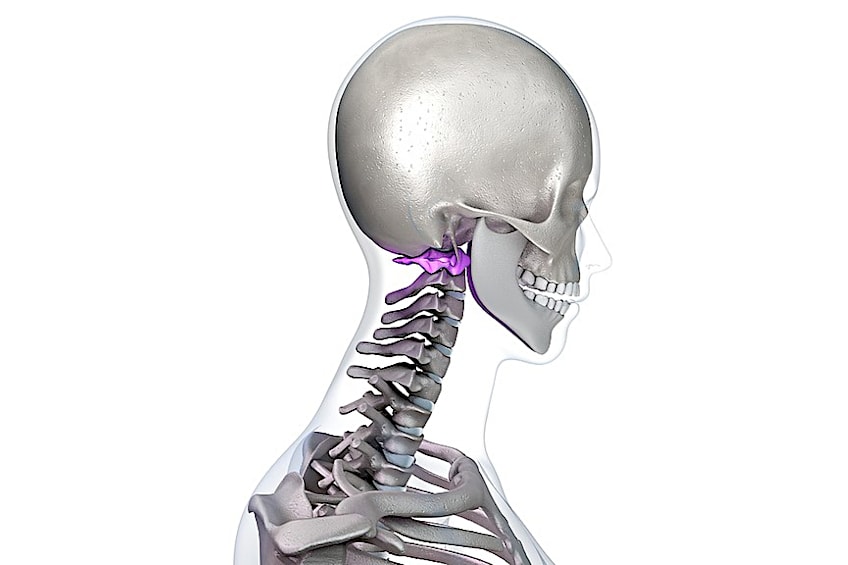 Diagram showing the location of the Atlas bone (marked in purple) in the human body; Jlabanimation, CC BY-SA 4.0, via Wikimedia Commons
Diagram showing the location of the Atlas bone (marked in purple) in the human body; Jlabanimation, CC BY-SA 4.0, via Wikimedia Commons
Psychology uses Atlas as a term to describe a person’s personality that has been characterized by a childhood heavy with responsibilities and stresses. Images of Atlas are prevalent in corporate spaces in the West as paragons of stoic endurance and resolute responsibility but can also be a symbol of crushing exploitation. In Ayn Rand’s controversial novel Atlas Shrugged, for example, the title references the dangers of a world where innovative leaders and incentives are discouraged and disappear.
In other words, when the ones society relies on, yet does not support, the Atlases of the world, die out or ‘shrug’, the society that depends on them will descend into chaos.
This is not to say that you should be wholly selfish or reluctant with responsibilities. Think carefully about what duty you pick up for you may not be able to put it down again easily. Moderate yourself to what you can and should do or else you run the risk of suffering under all you cannot. A burden shared is a burden halved is a phrase that also comes to mind, and we are sure Atlas would have appreciated the notion.
 First-edition dust jacket for Atlas Shrugged by Ayn Rand (1957); English: Published by Random House. Jacket design by George Salter. Photo portrait of Rand by Phyllis Cerf., Public domain, via Wikimedia Commons
First-edition dust jacket for Atlas Shrugged by Ayn Rand (1957); English: Published by Random House. Jacket design by George Salter. Photo portrait of Rand by Phyllis Cerf., Public domain, via Wikimedia Commons
Atlas as a dual symbol of strength and suffering is present in both his foremost role in ancient cosmography and our contemporary sayings but at the end of the day, is Atlas a titan of anything but endurance in all its shapes?
We live life by enduring challenges of all sizes. With determination and tenacity, you can overcome the greatest of hurdles and carry the largest of weights. It takes courage to keep going, and moving forward is the only way to do anything in life. Atlas may have been punished but as we see his name and image and story alive across the Western world more than two millennia later, can you really say it stopped him?
The dramatic image of Atlas Telamōn easily conjures thoughts of fearsome strength and the far reaches of sea and space. The story of this mysterious and tenacious personification of endurance resonates with us strongly, and we hope you found this figure of Greek mythology as fascinating to learn about as we have!
Frequently Asked Questions
What Is Atlas the God Of?
Atlas is the Titan that personifies the trait of endurance and strength. While not truly the god of either, Atlas is also associated with having superior knowledge of astronomy and navigation. The title of god of travelers belongs to Atlas’ grandson, the Greek god Hermes while, stars, astronomy, and astrology is the domain of the Muse Urania. Like Atlas, Urania’s symbol is the celestial sphere; though some attribute the creation of the first-ever celestial sphere to him.
What Are Atlas’ Symbols?
Atlas’ symbol is the celestial sphere, referring to his role as the heaven-bearer and his associations with the stars and astronomy. A common misconception in art and general thought sees the Greek god Atlas holding the world upon his shoulder. Atlas actually holds the heavens separate from the earth directly or with pillars, which is another lesser symbol some associate him with.
Why Was Atlas Punished?
It is not specifically stated why Atlas was given the punishment of bearing the heavens by Zeus. Despite the lack of referenced crime, the common convention holds that Atlas was punished for his role in leading the Titans into battle against the Olympians during the ten-year war known as Titanomachy. The special nature of his punishment has been speculated to be a tribute to how strong an opponent he was, or a show of power and warning by Zeus.

I am deeply passionate about history and am constantly fascinated by the rich and complex stories of the past. As the editor-in-chief of learning-history.com, I have the opportunity to share this passion with a wide audience through the creation and distribution of engaging and informative content about historical events, persons, and cultures. Whether it’s through writing articles and blog posts or creating videos or podcasts, I strive to bring the past to life in a way that is both accurate and enjoyable. My expertise in history, combined with my strong writing and communication skills, allows me to effectively communicate complex historical concepts and make them accessible and interesting to a wide range of readers. I am truly grateful for the opportunity to share my love of history with others through my work on learning-history.com.

